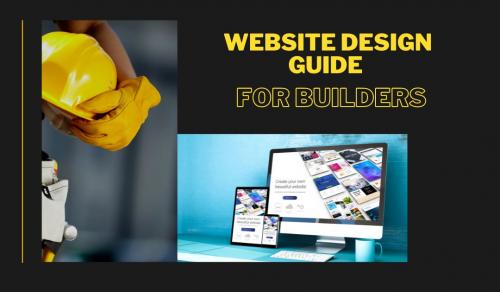Crafting Digital Success: The Ultimate Website Design Guide for Builders

As a builder or small business owner, your website serves as your virtual storefront, often being the first point of contact between you and potential clients. This comprehensive guide will walk you through the essential elements of effective website design for builders, helping you create a digital platform that not only showcases your work but also drives business growth.
Whether you're just starting out or looking to revamp your existing online presence, this article will provide you with valuable insights, practical tips, and inspiring examples to help you. From understanding the basics of good design to implementing SEO strategies, we'll cover everything you need to know to create a website that looks great and performs well in search engine rankings.
Let's dive in and explore how you can harness the power of effective website design to elevate your building business to new heights.
What Makes a Good Website for Builders?
When it comes to web design for builders, it's crucial to lay a solid foundation just as you would for any construction project. A well-designed website should reflect your brand, showcase your expertise, and provide visitors with a seamless user experience. Let's explore the key elements that contribute to an effective website for builders.
Clear and Professional Design
A clean, professional design instils confidence and reflects the quality of your work. Opt for a layout that's easy to navigate, with a colour scheme that complements your brand identity.
Consider using high-quality images of your completed projects as the backdrop for your homepage. This immediately gives visitors a visual representation of your capabilities and the quality of your work.
Intuitive Navigation
Your builders website should be easy to navigate, allowing visitors to find the information they need quickly. A well-structured menu with clear labels helps users explore your site effortlessly. Consider including categories such as 'Services', 'Portfolio', 'About Us', and 'Contact' in your main navigation menu.
Remember, most users decide within seconds whether they'll stay on a website or leave. By making navigation intuitive, you increase the chances of visitors staying longer and engaging with your content.
Compelling Content and Visuals
As a builder, your work is visual by nature. Leverage this by incorporating high-quality images and videos of your projects throughout your website. Create a dedicated portfolio section where you can showcase your best work, including before and after shots, time-lapse videos of ongoing projects, and testimonials from satisfied clients.
Pair these visuals with compelling content that describes your services, highlights your expertise, and communicates your unique selling points. Use clear, concise language that speaks directly to your target audience's needs and concerns.
Tips for Creating a User-Friendly and Attractive Website
Now that we understand the key elements of a good web design for builders, let's delve into the process of creating one. Designing a website can seem daunting, but by breaking it down into manageable steps, you can create an online presence that truly represents your business.
Start with a Clear Goal
Before you begin designing, it's essential to define the primary goal of your website. Are you looking to generate leads, showcase your portfolio, or provide information about your services? Having a clear objective will guide your design decisions and help you create a website that aligns with your business goals.
For example, if lead generation is your primary goal, you might want to prominently feature contact forms or call-to-action buttons throughout your site. If showcasing your work is the main objective, you might focus on creating an extensive, easy-to-navigate portfolio section.
Choose the Right Platform
While there are many options available, consider platforms that offer templates specifically designed for construction and building businesses. WordPress, Squarespace, and Wix are popular choices that offer user-friendly interfaces and customisable templates.
When choosing a platform, consider factors such as ease of use, customisation options, and the ability to scale as your business grows. Remember, your website for builders should be able to evolve with your business.
Prioritise User Experience
A website that's easy to use and navigate will keep visitors engaged and encourage them to explore further. Consider implementing features like a search function, breadcrumb navigation, and clear calls-to-action to enhance the user experience.
Pay attention to page load times as well. Delays in page loading can agitate users and result in an increase in bounce rates. Optimise your images, minimise the use of large files, and consider using a content delivery network (CDN) to improve your site's performance.
The Role of Mobile Responsiveness and SEO in Website Design
In today's digital landscape, having a website that looks great on desktop computers isn't enough. With more and more people accessing the internet via mobile devices, it's crucial that your website is mobile-responsive. Let's explore why this is important and how it ties into your overall SEO strategy.
Mobile Responsiveness: A Must-Have Feature
A mobile-responsive website ensures that your content is easily readable and navigable on smartphones and tablets, providing a seamless user experience across all devices.
For builders, this is particularly important. Potential clients might be browsing your portfolio while on a job site or looking up your contact information while on the go. If your website isn't mobile-friendly, you risk losing these potential leads.
Moreover, Google uses mobile-first indexing, meaning it predominantly uses the mobile version of a website for ranking and indexing. A mobile-responsive design is therefore not just good for user experience, but also crucial for your search engine rankings.
SEO: Making Your Website Visible
Search Engine Optimisation (SEO) is the practice of optimising your website to rank higher in search engine results pages (SERPs). For builders, local SEO is particularly important, as most of your clients are likely to be in your geographical area.
Start by incorporating relevant keywords throughout your website. These might include phrases like "website design for builders", "builders website design", or "web design for builders". However, be sure to use these naturally within your content – keyword stuffing can actually harm your rankings.
Create location-specific pages if you serve multiple areas. For example, if you're a builder in Sydney, you might have separate pages for "BuildersSydney" and "Home Builders Sydney".
Regularly update your website with fresh, relevant content. This could be in the form of blog posts about recent projects, industry news, or tips for homeowners. Not only does this provide value to your visitors, but it also signals to search engines that your website is active and relevant.
The Future of Website
As we look to the future, it's clear that effective website design will continue to play a crucial role in the success of building businesses. The digital landscape is constantly evolving, and staying ahead of the curve can give you a significant competitive advantage.
One trend we're likely to see more of is the integration of virtual and augmented reality technologies. Imagine allowing potential clients to take virtual tours of your completed projects or visualise how their own project might look when finished. These technologies have the potential to revolutionise how builders showcase their work and engage with clients online.
Another important consideration is the growing emphasis on sustainability in the construction industry. Your website can play a key role in communicating your commitment to sustainable building practices. Consider incorporating information about your eco-friendly approaches, certifications, or case studies of sustainable projects you've completed.
To Sum Up
In conclusion, your website is more than just a digital brochure – it's a powerful tool for growing your building business. By implementing the strategies we've discussed, from user-friendly design to effective SEO practices, you can create a website that not only attracts potential clients but also converts them into customers.
Remember, your website is an extension of your brand and should reflect the quality and professionalism of your work. Invest time and resources into creating a strong online presence, and you'll be well-positioned to thrive in the increasingly digital world of construction and building.
Whether you're creating a new website or improving an existing one, keep these principles in mind. With a well-designed, user-friendly, and SEO-optimised website, you'll be laying a strong foundation for your business's online success. Just as you wouldn't cut corners on a building project, don't compromise on your digital presence. Your web design for builders is an investment in your business's future – make it count.




Comments